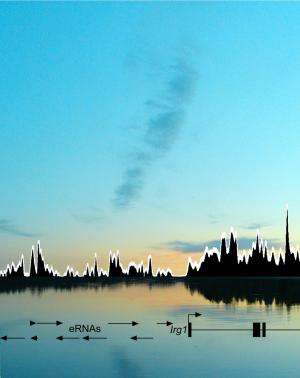Enhancer RNAs may open new avenues for gene therapy

A study investigating the function of the recently discovered enhancer RNA molecules may open new avenues for gene therapy. According to the study researchers, altering the production and function of these molecules could affect the expression of genes and, in consequence, possibly also the progression of various diseases. Published in the prestigious Molecular Cell on 8 August, the study was carried out in collaboration between the University of California, San Diego and the University of Eastern Finland.
Besides promoters located in the beginning of genes, gene expression is also regulated by enhancers which may be located as far as thousands of base pairs away from the gene they regulate. Enhancers have been shown to be responsible for cell-specific gene regulation. Previously, it was thought that the number of enhancer sequences in a differentiated cell is static; however, recent findings are starting to disprove the idea. In 2010, it was discovered that non-coding RNA molecules were being produced from the enhancer regions. The first observations relating to the biological function of these enhancer RNAs, or eRNAs, were published earlier this year. However, no study to date has addressed the question of whether enhancer transcription is of functional importance.
In the study researchers used genome-wide approaches to demonstrate that inflammation response causes the emergence of novel enhancers in primary macrophage cells. For the first time ever, the study used this formation of novel enhancer regions to describe the selection of enhancers and the progression of the activation from transcription factor binding to histone acetylation and eRNA transcription, finally leading to the mono- and dimethylation of histone H3 lysine 4 (H3K4me1/2). The H3K4me1 and H3K4me2 histone modifications are the very markers generally used to identify the location of enhancer regions on DNA. This type of histone methylation enables the function of these regions as enhancer sequences, i.e. as marks that can be identified by specific proteins which boost gene transcription.
The study showed that the direction and extent of eRNA transcription and H3K4me1/2 regions show strong correlation and that the inhibition of eRNA transcription with polymerase inhibitors inhibited histone methylation and thus also the emergence of novel enhancer sequences. Furthermore, the study showed that histone methyltransferases Mll1, Mll2/4 and Mll3 play a key role in de novo H3K4 methylation.
The results show that enhancer transcription causes long-term epigenetic changes in cells. Furthermore, besides offering valuable insight into the function of this novel RNA type, the researchers also believe that the findings will open new avenues for novel treatments in which cell-specific enhancer sequences can be targeted to alter gene expression. In June, this same group of researchers published a study in Nature, reporting for the first time reduction in target gene expression using eRNA knockdown in experimental animals.
More information: Lam, M. et al. Rev-Erbs negatively regulate macrophage gene expression by repressing enhancer-directed transcription. Nature 2013 Jun 27; 498(7455):511-5. www.nature.com/nature/journal/ … ull/nature12209.html
Kaikkonen, M. et al. Remodeling of the enhancer landscape during macrophage activation is linked to enhancer transcription.. Molecular cell, 2013; Volume 51, Issue 3, 310-325. www.cell.com/molecular-cell/ab … 1097-2765(13)00509-1
Journal information: Nature , Molecular Cell
Provided by University of Eastern Finland

















